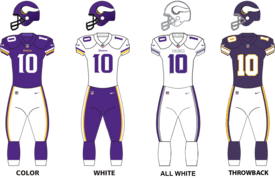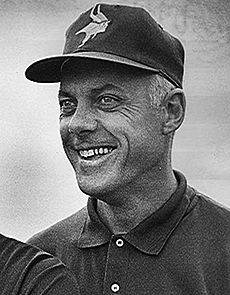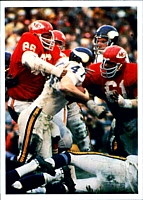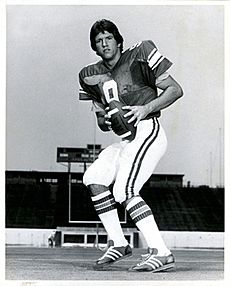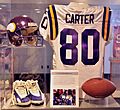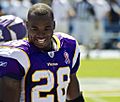Minnesota Vikings facts for kids
Quick facts for kids Minnesota Vikings |
|||||||||||||
|---|---|---|---|---|---|---|---|---|---|---|---|---|---|
|
|||||||||||||
| Basic info | |||||||||||||
| Established | January 28, 1960 | ||||||||||||
| Stadium | U.S. Bank Stadium Minneapolis, Minnesota |
||||||||||||
| Headquartered | TCO Performance Center Eagan, Minnesota |
||||||||||||
| Colors | Purple, gold, white |
||||||||||||
| Fight song | Skol, Vikings | ||||||||||||
| Mascot | Viktor the Viking | ||||||||||||
| Personnel | |||||||||||||
| Owner(s) | Zygi, Leonard and Mark Wilf | ||||||||||||
| Chairman | Zygi Wilf | ||||||||||||
| President | Mark Wilf | ||||||||||||
| General manager | Kwesi Adofo-Mensah | ||||||||||||
| Head coach | Kevin O'Connell | ||||||||||||
| Nicknames | |||||||||||||
|
|||||||||||||
| Team history | |||||||||||||
|
|||||||||||||
| Home fields | |||||||||||||
|
|||||||||||||
| League / conference affiliations | |||||||||||||
National Football League (1961–present)
|
|||||||||||||
| Championships | |||||||||||||
League championships: 0†
|
|||||||||||||
Conference championships: 4
|
|||||||||||||
Division championships: 21
|
|||||||||||||
| Playoff appearances (32) | |||||||||||||
|
|||||||||||||
| Owner(s) | |||||||||||||
|
|||||||||||||
The Minnesota Vikings are a professional American football team located in Minneapolis. They play in the National Football League (NFL) as part of the National Football Conference (NFC) North division. The team started in 1960 as a new expansion team and began playing games in 1961. They are named after the Vikings of medieval Scandinavia, which reflects the strong Scandinavian American culture in Minnesota. The Vikings play their home games at U.S. Bank Stadium in Minneapolis.
The Vikings have a strong overall record of 537 wins, 438 losses, and 11 ties. They have the best winning percentage among NFL teams that have not won a Super Bowl. They also have many playoff appearances, division titles, and are tied with the Buffalo Bills for the most Super Bowl appearances without a win. The Vikings are one of only four teams to appear in a conference championship game in every decade since the 1970s.
Contents
- Team History: From the Start to Today
- Team Look: Logo and Uniforms
- Team Spirit: Mascots and Songs
- Team Rivalries: Who Do They Play?
- Players: Team Legends
- Coaches: Leading the Team
- Radio and Television: How to Watch and Listen
- Images for kids
- See also
Team History: From the Start to Today
Professional football in the Minneapolis–Saint Paul area, also known as the "Twin Cities," began with the Minneapolis Marines/Red Jackets. This NFL team played on and off in the 1920s and 1930s. A new professional team for the area was created in August 1959. Minnesota businessmen Bill Boyer, H. P. Skoglund, and Max Winter were given a team in the new American Football League (AFL).
Just five months later, in January 1960, the ownership group decided to join the NFL instead. They were given the NFL's 14th team, set to start playing in 1961. Ole Haugsrud joined the NFL team's ownership. This was because, in the 1920s, when he sold his Duluth Eskimos team back to the league, he was promised 10 percent of any future Minnesota team. The teams from Ole Haugsrud's high school in Superior, Wisconsin, were also called the Vikings and had similar purple and yellow colors.
From their first season in 1961 until 1981, the Vikings played at Metropolitan Stadium in Bloomington. Their summer training camp was at Bemidji State University from 1961 to 1965. In 1966, the team moved its training camp to Minnesota State University in Mankato. This training camp was one of the longest-running in the NFL. The Vikings played their home games at the Hubert H. Humphrey Metrodome in Minneapolis from 1982 to 2013. Their last game at the Metrodome was on December 29, 2013, where they beat the Detroit Lions 14–13.
Since 1961, the Vikings have had one of the best winning percentages in the NFL. As of 2022, they have won at least three games every season except 1962. They are one of only seven NFL teams to win at least 15 games in a regular season. The Vikings won one NFL Championship in 1969, before the NFL joined with the American Football League (AFL) in 1970. Since the merger, the team has made the playoffs 28 times, which is the third-most in the league. The team played in Super Bowls IV, VIII, IX, and XI, but they did not win any of them. They have also lost their last six NFC Championship Game appearances, going back to 1978. The Vikings have 15 members in the Pro Football Hall of Fame.
The 1960s: A New Team Takes Shape
The team was officially named the Minnesota Vikings on September 27, 1960. The name was chosen to show Minnesota's connection to Scandinavian American culture. From the start, the Vikings had a strong marketing plan. This led to almost 26,000 season tickets sold in the first year. The average home attendance was 34,586, which was about 85 percent of Metropolitan Stadium's capacity. The stadium's capacity was later increased to 47,900.
Bert Rose, who used to work for the Los Angeles Rams, became the team's first general manager. The team hired Norm Van Brocklin as their first head coach on January 18, 1961. Van Brocklin had just finished his playing career by winning the 1960 NFL Championship Game.
As a new team, the Vikings had the first pick in the 1961 NFL draft. They chose running back Tommy Mason. They also picked a young quarterback named Fran Tarkenton in the third round. The Vikings won their first regular-season game, beating the Chicago Bears 37–13 in 1961. Tarkenton came off the bench to throw four touchdown passes and run for another. However, the team then lost its next seven games and finished with a 3–11 record. The team continued to struggle through much of the 1960s.
On March 7, 1967, quarterback Fran Tarkenton was traded to the New York Giants. On March 10, 1967, the Vikings hired Bud Grant as their new head coach. Grant came from the Canadian Football League, where he led the Winnipeg Blue Bombers to four championships. Joe Kapp, an experienced CFL veteran, replaced Tarkenton at quarterback. In the late 1960s, the Vikings built a very strong defense known as the Purple People Eaters. This defense was led by Alan Page, Carl Eller, Gary Larsen, and Jim Marshall. In 1968, this tough defense helped the Vikings win their first Central Division title and make their first playoff appearance.
In 1969, the Vikings had a great 12–2 record. They won 12 straight regular-season games after losing their first game. The Vikings defeated the Cleveland Browns 27–7 in the last pre-merger NFL Championship Game on January 4, 1970. This made the Vikings the first modern NFL expansion team to win an NFL Championship. They earned a spot in Super Bowl IV, but they lost to the Kansas City Chiefs, 23–7.
The 1970s: Super Bowl Appearances
The team continued to play well in 1970 and 1971, reaching the playoffs. In 1971, Alan Page won the NFL Most Valuable Player Award. He was the first defensive player to win this award.
On January 27, 1972, the Vikings traded to get Fran Tarkenton back from the New York Giants. The team also drafted running back Chuck Foreman in the 1973 draft. The Vikings won their first nine games of 1973 and finished with a 12–2 record. They then went to their second Super Bowl, Super Bowl VIII, but lost to the Miami Dolphins, 24–7.
The Vikings won their division again in 1974 with a 10–4 record. They defeated the St. Louis Cardinals and the Los Angeles Rams in the playoffs. The Vikings played in their second straight Super Bowl, Super Bowl IX, but lost to the Pittsburgh Steelers, 16–6.
In 1975, the Vikings started with a 10–0 record and won another division title. However, they lost to the Dallas Cowboys in the playoffs, 17–14. This game ended with a controversial touchdown pass known as the Hail Mary.
The Vikings played in Super Bowl XI, their third Super Bowl in four years, but lost to the Oakland Raiders 32–14. In 1977, the Vikings won their division again but were defeated by the Cowboys in the NFC Championship Game. By 1978, the team was getting older, but still made the playoffs. Quarterback Fran Tarkenton retired after this season.
In December 1979, construction began for the Hubert H. Humphrey Metrodome in downtown Minneapolis.
The 1980s: New Stadium and Coaching Changes
On May 15, 1981, the Vikings moved into a new facility in Eden Prairie. This complex was named "Winter Park" after Max Winter, one of the team's founders. The Vikings played their last game at Metropolitan Stadium on December 20, 1981.
The Vikings played their first game at the Metrodome on August 21, 1982. The first regular-season game there was on September 12, 1982, when the Vikings beat Tampa Bay. The Vikings also played the first international NFL game in London on August 6, 1983.
On January 27, 1984, Bud Grant retired as head coach. He led the team to 12 playoff appearances and four Super Bowls. Les Steckel became the new head coach, but the Vikings had a very tough season, losing 13 games. Steckel was fired, and Bud Grant returned as head coach on December 18, 1984.
On January 6, 1986, Bud Grant retired for good. Jerry Burns became the fourth head coach. In his first season, the Vikings had a winning record of 9–7. On August 2, 1986, Fran Tarkenton was the first player who spent most of his career with the Vikings to be inducted into the Pro Football Hall of Fame.
After the strike-shortened 1987 season, the Vikings made two big upsets in the playoffs. They defeated the New Orleans Saints and the San Francisco 49ers. In the NFC Championship Game, they lost to the Washington Redskins in a close game.
On October 12, 1989, the Vikings made a big trade for Herschel Walker from Dallas. However, Walker's performance with the Vikings was not as good as expected.
The 1990s: A Strong Offense and Close Calls

On December 3, 1991, Jerry Burns retired as head coach. Dennis Green was named the fifth head coach. In his 10 seasons, Green led the Vikings to four division titles and eight playoff appearances. The Vikings had one of the best winning percentages in the NFL during the 1990s.
The 1998 Season: Record-Breaking Offense
The 1998 season was unforgettable for the Vikings. They had an amazing offense led by quarterback Randall Cunningham, running back Robert Smith, and wide receivers Cris Carter and Randy Moss. The Vikings set an NFL record by scoring 556 points that season. They finished the season with a 15–1 record. Their only loss was to the Tampa Bay Buccaneers.
In the playoffs, the Vikings easily beat the Arizona Cardinals. They were favored to win their NFC Championship game against the Atlanta Falcons. However, kicker Gary Anderson missed a field goal late in the game. The Falcons tied the game and then won 30–27 in overtime. The Vikings became the first 15–1 team to not reach the Super Bowl.
The 1999 Season: Another Playoff Run
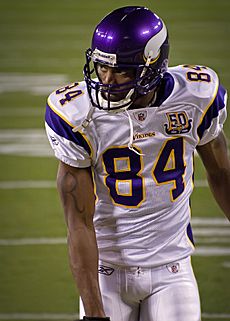
In 1999, Jeff George became the starting quarterback. He led the Vikings to a 10–6 record and another playoff spot. Minnesota beat Dallas in the Wild Card game. They then faced the St. Louis Rams in a high-scoring game, losing 49–37.
The 2000s: Ups and Downs
The Vikings started the 2000s by winning their division and reaching the NFC Championship game, where they lost 41–0 to the New York Giants. The next season, they struggled with a 5–11 record. They made the playoffs again in 2004 but did not win a division title until 2008. This decade had the fewest playoff appearances for the team since the merger.
The 2000 Season: Championship Game Loss
In 2000, the Vikings had an 11–5 record. They made the playoffs for the fifth year in a row. After beating the Saints in the Divisional game, they faced the Giants in the NFC Championship Game. The Vikings lost 41–0, which was their worst playoff defeat ever.
2001–2005: Coaching Changes and Key Departures
In 2001, after a disappointing 5–11 season, the Vikings fired Dennis Green. Mike Tice became the new head coach. In 2002, the Vikings became part of the new NFC North division.
During the 2003 season, the Vikings almost made the playoffs. However, the Arizona Cardinals scored a game-winning touchdown with no time left, knocking the Vikings out. The Vikings became the second team in NFL history to miss the playoffs after starting 6–0.
In 2004, quarterback Daunte Culpepper had an amazing season. He threw for 4,717 yards and 39 touchdowns. In the wild card game, the Vikings defeated the Green Bay Packers at Lambeau Field. They became the second team in NFL history to have an 8–8 record and win a playoff game. However, they lost to the Philadelphia Eagles in the next round.
On March 2, 2005, wide receiver Randy Moss was traded to the Oakland Raiders. After a tough start to the 2005 season, Daunte Culpepper suffered a season-ending knee injury. The Vikings finished the 2005 season with a 9–7 record. An incident involving some team members on a boat caused a scandal, leading to charges for a few players. Mike Tice was fired after the 2005 season and replaced by Brad Childress.
2006–2008: Adrian Peterson Arrives
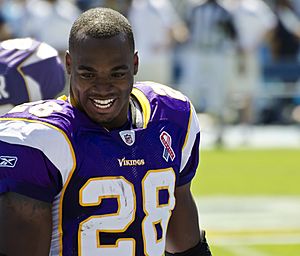
The Vikings started the 2006 season well but finished 6–10. With their draft pick, they selected Adrian Peterson from the University of Oklahoma. Peterson quickly made an impact. In Week 9, he broke the NFL single-game rushing record with 296 yards against the San Diego Chargers. Despite a strong middle of the season, the Vikings finished 8–8 and missed the playoffs.
In the 2008 season, Adrian Peterson led the NFL with 1760 rushing yards, breaking the team record. The Vikings won the NFC North championship for the first time since 2000. On January 4, 2009, the Vikings hosted the Philadelphia Eagles in the playoffs, but lost 26–14.
The Vikings defense was known for being strong against the run, led by the "Williams Wall" of Kevin Williams and Pat Williams. With the addition of Jared Allen in 2008, their defensive line became very powerful.
2009: Brett Favre's Impact
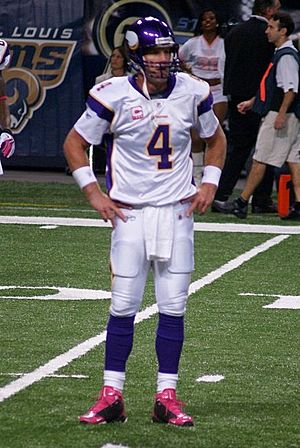
On August 18, 2009, veteran quarterback Brett Favre, who had played many years for the rival Green Bay Packers, signed a two-year deal with the Vikings. On October 5, 2009, Favre played against his former team, the Green Bay Packers. The Vikings won 30–23, and Favre became the first quarterback to defeat all 32 NFL teams as a starter.
The Vikings finished the regular season with a 12–4 record, their best since 1998. They beat the Dallas Cowboys 34–3 in the divisional round, advancing to the NFC Championship game. They faced the top-seeded Saints in New Orleans. Despite playing well, the Vikings had five turnovers and lost in overtime, 31–28.
The 2010s: New Stadium and Playoff Moments
The Vikings made the playoffs four times in the 2010s. They had many different quarterbacks during this decade. However, the team improved after the 2013 season, including reaching the NFC Championship in 2017.
2010–2013: Challenges and Adrian Peterson's Big Year
In the 2010 season, the Vikings struggled. They traded for Randy Moss but then released him a month later. There were also issues with the Metrodome roof collapsing due to snow, which forced games to be moved. Head coach Brad Childress was fired, and Leslie Frazier took over. The Vikings finished 6–10.
On January 17, 2011, Brett Favre retired for the last time. The team then drafted quarterback Christian Ponder. The team finished the 2011 season with a 3–13 record, one of the worst in franchise history.

In the 2012 NFL draft, the Vikings picked lineman Matt Kalil and safety Harrison Smith. These players helped the Vikings reach the playoffs. After beating the Packers in the final game of 2012, the Vikings lost to them in the wild-card round. Adrian Peterson was named the league's MVP, rushing for 2,097 yards, which was the second-most in NFL history.
In the 2013 season, the Vikings finished with five wins, ten losses, and one tie. This was the last season played at the Metrodome. Leslie Frazier was fired after the season.
2014–2019: Mike Zimmer and the Minneapolis Miracle
The team hired Mike Zimmer as head coach on January 16, 2014. In the 2014 NFL draft, the Vikings selected linebacker Anthony Barr and quarterback Teddy Bridgewater. Bridgewater became the starter after Matt Cassel was injured. Running back Adrian Peterson played only one game due to a legal issue. The Vikings finished with seven wins and nine losses.
On January 3, 2016, the Vikings beat Green Bay to win the NFC North for the first time since 2009. They finished the 2015 season with an 11–5 record and made the playoffs. However, they lost to the Seattle Seahawks 10–9 after a missed field goal in a very cold game.
In 2016, after Teddy Bridgewater suffered a knee injury, the Vikings traded for quarterback Sam Bradford. Bradford had a good season, but the team finished 8–8. On February 28, 2017, the Vikings decided not to keep Adrian Peterson, making him a free agent. He holds many Vikings records, including most career rushing touchdowns and yards.
In 2017, the Vikings won the NFC North again with a 13–3 record. In the divisional round of the playoffs, they played the New Orleans Saints. With seconds left, quarterback Case Keenum threw a pass to wide receiver Stefon Diggs. Diggs ran for a touchdown, winning the game in a play known as the 'Minneapolis Miracle'. The Vikings then went to the NFC Championship game, hoping to play in the Super Bowl in their own stadium. However, they lost 38–7 to the Philadelphia Eagles.
On March 15, 2018, quarterback Kirk Cousins signed a large contract with the Vikings. The Vikings finished the 2018 season with an 8–7–1 record and missed the playoffs.
On September 22, 2019, the Vikings defeated the Oakland Raiders for their 500th win as a team. The team finished the 2019 season at 10–6 and earned a wild card spot. The Vikings upset the New Orleans Saints 26–20 in overtime in the wild card round. They then lost to the San Francisco 49ers 10–27 in the divisional round.
The 2020s: Recent Seasons
2020: Justin Jefferson's Arrival
The Vikings used their 22nd pick in the 2020 NFL draft on wide receiver Justin Jefferson. After losing to the New Orleans Saints on Christmas Day, the Vikings were out of the 2020 playoffs. The Vikings finished 7–9 in 2020, their first losing season since 2014.
2021: Coaching Changes
In 2021, the Vikings missed the playoffs for the second season in a row. After the season ended, the team fired head coach Mike Zimmer and general manager Rick Spielman on January 10, 2022.
2022: New Leadership and Division Title
On January 26, 2022, the Vikings hired Kwesi Adofo-Mensah as their new general manager. On February 16, Kevin O'Connell was named the team's 10th head coach. The Vikings finished the regular season as NFC North champions with a 13–4 record. They set an NFL record by winning 11 games decided by one score. The Vikings entered the playoffs as the number three seed but lost to the New York Giants 31–24 in the wild-card round.
2023: Quarterback Changes
In Week 8 of the 2023 season, Kirk Cousins suffered a season-ending Achilles injury. The Vikings used several quarterbacks for the rest of the year. The team finished the 2023 season with a 7–10 record. In the offseason, Cousins left for the Atlanta Falcons. The Vikings used their 10th pick in the 2024 NFL draft on Michigan quarterback J. J. McCarthy.
2024: Sam Darnold's Breakout Season
First-round draft pick J. J. McCarthy was expected to compete for the starting quarterback job with Sam Darnold. However, McCarthy had knee surgery after a pre-season game, ending his season. Darnold became the starter and had a breakout season. By Week 17, he led the Vikings to a 14–2 record, becoming the first quarterback in the NFL to win 14 games in their first season with a team.
Team Look: Logo and Uniforms
The Vikings' famous horned helmet and purple-and-gold uniforms were designed by cartoonist Karl Hubenthal. He also designed the first Norseman logo.
From 1961 to 1995, the Vikings' logos and uniforms stayed mostly the same. The team's main logos show a blond Norseman (a Viking warrior) and a white Viking horn. These reflect Minnesota's Scandinavian heritage.
The team's helmet is purple with a Viking horn on each side, outlined in gold. The horn logo was slightly updated in 2006. The original uniform had white pants, gold trim, and either purple or white jerseys. There have been small changes over the years, like changing the face mask color from gray to white in 1980, then to purple in 1985. In 1996, the Norseman logo was added to the sleeves. The Vikings were the last NFL team to switch from black shoes to white shoes in 1984. In 2006, they returned to black shoes.
The Vikings updated their Norseman logo on February 14, 2013, making the gold brighter and changing some shapes. New uniforms were shown on April 25, 2013.
The team's uniforms were redesigned in 2006, the first big change in 46 years. Trim lines were added to the shoulders, sleeves, and sides of the jerseys and pants. The horn on the helmet was also made clearer.
The team has worn special patches on their jerseys for anniversaries or to remember people. For example, they wore "TS" decals on their helmets in 2018 to remember assistant coach Tony Sparano.
On December 24, 2022, the Vikings wore all-white uniforms at home for the first time in a regular season game. This was part of a "Winter Whiteout" event. They did this again on December 24, 2023. On June 6, 2024, the Vikings showed off a new alternate "Winter Warrior" uniform, which is all-white with purple and silver stripes and a new wordmark. It comes with an alternate white helmet.
In 2023, the Vikings also showed throwback uniforms based on their 1960s purple uniforms.
All-Purple Uniforms: A Unique Look
On October 11, 1964, the Vikings accidentally wore all-purple for a game. It was not until December 17, 2007, that they intentionally wore all-purple again. This was for a Monday Night Football game against the Chicago Bears.
The NFL introduced "Color Rush" uniforms in 2016 for Thursday Night Football games. The Vikings had an all-purple uniform with gold numbers and stripes. These uniforms are now called "Primetime Purple" and are worn for home Thursday Night games. The Vikings also wore all-purple for a playoff game against the New Orleans Saints in 2019, and again in 2020 and 2022.
All-White Uniforms: The Winter Warrior
On June 6, 2024, the Minnesota Vikings showed their new all-white "Winter Warrior" uniform. It has a white helmet with a metallic gray stripe, inspired by traditional Viking helmets. This uniform is the first in Vikings history to include a white helmet. These uniforms were worn for their 2024 Winter Whiteout game.
Team Spirit: Mascots and Songs
Mascots: Viktor and More
After trying different ideas, the Vikings finally introduced Viktor the Viking as their official mascot during the 2007 season. Viktor is a strong, blond-haired character who wears a Vikings jersey and a large Vikings helmet.
From 1970 to 1992, a truck driver named Hub Meeds dressed as a Viking and was the team mascot. From 1994 to 2015, the mascot was Ragnar, played by Joseph Juranitch. Ragnar would ride onto the field on a motorcycle. In 2015, the Vikings and Juranitch could not agree on a new contract, so he left.
Another mascot was "Vikadontis Rex," a purple dinosaur. He was the mascot for the Minnesota Vikings Children's Fund. The team also had an NFL Huddles mascot in the 1980s.
Fight Songs: Skol, Vikings!
"Skol, Vikings" is the official fight song of the Minnesota Vikings. It was created around 1961. It is played whenever the team scores a touchdown, field goal, or safety, and at the end of each half and after a victory.
The song "Purple and Gold" was recorded in 2010 by Minneapolis musician Prince. It was also used as a fight song for the team.
Helga Hats: Fan Tradition
Vikings fans are famous for wearing "Helga hats." These are purple hats with white horns and blonde braids. They look like the helmets that people imagine Viking warriors wore. The original Helga Hats are still made by hand in the Twin Cities area.
Vikings Horn: A Powerful Sound
During home games, the Vikings play their Gjallarhorn before the game. This tradition started in 2007. It's a way to honor past Vikings legends and other important people from Minnesota. The first horn broke in 2016 due to very cold temperatures.
Skol Chant: A Fan Cheer
The Skol Chant is a cheer used at U.S. Bank Stadium during Vikings games. Fans clap their hands above their heads and yell "Skol" to the beat of a drum. This chant is similar to the Viking War Cry used by the Iceland national football team fans.
Skol (or "skål" in other languages) is a Danish, Norwegian, and Swedish word meaning "cheers" or "good health." It's a way to toast someone or a group.
Team Rivalries: Who Do They Play?
Divisional Rivals: Close Competitors
Chicago Bears: A Long-Standing Rivalry
The Vikings' rivalry with the Chicago Bears began when the Vikings joined the league in 1961. Both teams are in the NFC North and play at least twice a year. The Vikings lead the overall series with 65 wins, 57 losses, and 2 ties. They have met once in the playoffs, with the Bears winning in 1994.
Detroit Lions: No Playoff Meetings Yet
The Vikings and Detroit Lions have played twice every year since 1961. They are both in the NFC North. This is the only NFC North rivalry that has not had any playoff games between the teams. The Vikings lead the all-time series with 80 wins, 41 losses, and 2 ties.
Green Bay Packers: The Biggest Rivalry
The rivalry between the Vikings and the Green Bay Packers started in 1961. This is considered the most important rivalry in the NFC North. Events like Randy Moss's celebration in Green Bay and former Packers star Brett Favre joining the Vikings have made this rivalry even more intense. The Packers lead the all-time series with 66 wins, 60 losses, and 3 ties, but the teams have split their two playoff games.
Conference Rivals: Big Playoff Games
New Orleans Saints: A Heated Matchup
The Vikings have a strong rivalry with the New Orleans Saints. The Vikings lead the overall series 23–13, including a 4–1 record in the playoffs. This rivalry has featured many memorable playoff games, such as the 2009 NFC Championship Game and the 2017 NFC Divisional Round game.
Historic Rivals: Past Playoff Battles
Dallas Cowboys: 1970s Showdowns
The rivalry between the Cowboys and the Vikings became very intense in the 1970s. Many of their games affected the NFC playoff race during that time. The Cowboys lead the all-time series 19–15, and have a 4–3 record against the Vikings in the playoffs.
Los Angeles Rams: Frequent Playoff Opponents
The Vikings' rivalry with the Los Angeles Rams was most intense in the 1970s. The two teams played many important playoff games. The Vikings lead the all-time series 27–18–1 and have a 5–2 record in the playoffs against the Rams.
Players: Team Legends
Current Roster
|
Minnesota Vikings roster
|
|||||||||
|---|---|---|---|---|---|---|---|---|---|
Quarterbacks
Running backs
Wide receivers
Tight ends
|
Offensive linemen
Defensive linemen
|
Linebackers
Defensive backs
Special teams
|
Reserve lists
→ AFC rosters → NFC rosters |
||||||
Retired Numbers: Honoring Greats
| Minnesota Vikings retired numbers | ||||
|---|---|---|---|---|
| No. | Player | Position | Tenure | Retired |
| 10 | Fran Tarkenton | QB | 1961–1966 1972–1978 |
October 7, 1979 |
| 53 | Mick Tingelhoff | C | 1962–1978 | November 25, 2001 |
| 70 | Jim Marshall | DE | 1961–1979 | November 28, 1999 |
| 77† | Korey Stringer | OT | 1995–2000 | November 19, 2001 |
| 80 | Cris Carter | WR | 1990–2001 | September 14, 2003 |
| 88 | Alan Page | DT | 1967–1978 | September 25, 1988 |
- † = Posthumous (honored after death)
Pro Football Hall of Famers: The Best of the Best
| Minnesota Vikings Hall of Famers | ||||
|---|---|---|---|---|
| Players | ||||
| No. | Name | Position(s) | Tenure | Inducted |
| 1 | Warren Moon | QB | 1994–1996 | 2006 |
| 3 | Jan Stenerud | K | 1984–1985 | 1991 |
| 4 | Brett Favre | QB | 2009–2010 | 2016 |
| 7 | Morten Andersen | K | 2004 | 2017 |
| 10 | Fran Tarkenton | QB | 1961–1966 1972–1978 |
1986 |
| 22 | Paul Krause | S | 1968–1979 | 1998 |
| 39 | Hugh McElhenny | RB | 1961–1962 | 1970 |
| 44 | Dave Casper | TE | 1983 | 2002 |
| 53 | Mick Tingelhoff | C | 1962–1978 | 2015 |
| 56 | Chris Doleman | DE | 1985–1993, 1999 | 2012 |
| 58 | Jim Langer | C | 1980–1981 | 1987 |
| 64 | Randall McDaniel | G | 1988–1999 | 2009 |
| 65 | Gary Zimmerman | OT | 1986–1992 | 2008 |
| 69 | Jared Allen | DE | 2008–2013 | 2025 |
| 73 | Ron Yary | OT | 1968–1981 | 2001 |
| 76 | Steve Hutchinson | G | 2006–2011 | 2020 |
| 80 | Cris Carter | WR | 1990–2001 | 2013 |
| 81 | Carl Eller | DE | 1964–1978 | 2004 |
| 84 | Randy Moss | WR | 1998–2004, 2010 | 2018 |
| 88 | Alan Page | DT | 1967–1978 | 1988 |
| 93 | John Randle | DT | 1990–2000 | 2010 |
| Coaches and Executives | ||||
| Name | Position(s) | Tenure | Inducted | |
| Jim Finks | GM | 1964–1973 | 1995 | |
| Bud Grant | HC | 1967–1983, 1985 | 1994 | |
Italics = played only a small part of their career with the Vikings, and are mostly known for what they did with other teams.
Ring of Honor: Vikings Legends
| Elected to the Pro Football Hall of Fame |
| Minnesota Vikings Ring of Honor | ||||
|---|---|---|---|---|
| Players | ||||
| No. | Name | Position(s) | Tenure | Inducted |
| 10 | Fran Tarkenton | QB | 1961–1966 1972–1978 |
September 9, 1998 |
| 20 | Bobby Bryant | CB | 1967–1980 | September 22, 2024 |
| 22 | Paul Krause | S | 1968–1979 | November 15, 1998 |
| 28 | Ahmad Rashad | WR | 1976–1982 | October 1, 2017 |
| 30 | Bill Brown | RB | 1962–1974 | September 26, 2004 |
| 44 | Chuck Foreman | RB | 1973–1979 | September 30, 2007 |
| 47 | Joey Browner | S | 1983–1991 | October 27, 2013 |
| 53 | Mick Tingelhoff | C | 1962–1978 | November 25, 2001 |
| 55 | Scott Studwell | LB | 1977–1990 | November 29, 2009 |
| 56 | Chris Doleman | DE | 1985–1993, 1999 | October 23, 2011 |
| 59 | Matt Blair | LB | 1974–1985 | October 25, 2012 |
| 64 | Randall McDaniel | G | 1988–1999 | December 17, 2006 |
| 69 | Jared Allen | DE | 2008–2013 | October 30, 2022 |
| 70 | Jim Marshall | DE | 1961–1979 | November 28, 1999 |
| 73 | Ron Yary | OT | 1968–1981 | September 9, 2001 |
| 77 | Korey Stringer | OT | 1995–2000 | November 19, 2001 |
| 80 | Cris Carter | WR | 1990–2001 | September 14, 2003 |
| 81 | Carl Eller | DE | 1964–1978 | November 10, 2002 |
| 83 | Steve Jordan | TE | 1982–1994 | October 24, 2019 |
| 84 | Randy Moss | WR | 1998–2004, 2010 | September 11, 2017 |
| 88 | Alan Page | DT | 1967–1978 | September 20, 1998 |
| 93 | John Randle | DT | 1990–2000 | November 30, 2008 |
| 93 | Kevin Williams | DT | 2003–2013 | October 3, 2021 |
| Coaches and Executives | ||||
| Name | Position(s) | Tenure | Inducted | |
| Jerry Burns | HC | 1986–1991 | November 6, 2005 | |
| Jim Finks | GM | 1964–1973 | October 18, 1998 | |
| Bud Grant | HC | 1967–1983, 1985 | November 8, 1998 | |
| Dennis Green | HC | 1992–2001 | September 23, 2018 | |
| Fred Zamberletti | Medical adviser | 1961–2011 | December 20, 1998 | |
Coaches: Leading the Team
Head Coaches: Who Has Led the Vikings?
The Vikings have had ten head coaches in their history. Bud Grant served as head coach two separate times.
| Name | Years | Won | Lost | Ties | Winning % | Postseason |
|---|---|---|---|---|---|---|
| Norm Van Brocklin | 1961–1966 | 29 | 51 | 4 | .345 | — |
| Bud Grant | 1967–1983, 1985 | 158 | 96 | 5 | .610 | 1968–71, 1973–78, 1980, 1982 |
| Les Steckel | 1984 | 3 | 13 | 0 | .188 | — |
| Jerry Burns | 1986–1991 | 52 | 43 | 0 | .547 | 1987–89 |
| Dennis Green | 1992–2001 | 97 | 62 | 0 | .610 | 1992–94, 1996–2000 |
| Mike Tice | 2001–2005 | 32 | 33 | 0 | .492 | 2004 |
| Brad Childress | 2006–2010 | 39 | 35 | 0 | .527 | 2008, 2009 |
| Leslie Frazier | 2010–2013 | 21 | 32 | 1 | .398 | 2012 |
| Mike Zimmer | 2014–2021 | 72 | 56 | 1 | .562 | 2015, 2017, 2019 |
| Kevin O'Connell | 2022–present | 34 | 17 | 0 | .667 | 2022, 2024 |
| Total | 537 | 438 | 11 | .545 | 32 | |
Current Staff: Who Works for the Team Now?
|
→ Coaching staff |
|||||
Radio and Television: How to Watch and Listen
The Vikings' main radio station is KFXN-FM (100.3), known as "KFAN." Games are also broadcast on the "KFAN Radio Network" across Minnesota, Wisconsin, Iowa, South Dakota, and North Dakota. Paul Allen has been the play-by-play announcer since 2002.
Preseason games not shown on national TV are aired on KMSP (Channel 9) in the Twin Cities.
Images for kids
-
Cris Carter's Hall of Fame display. Carter was a Viking from 1990 to 2001.
-
Randy Moss (1998–2004 and 2010)
-
All-Pro running back Adrian Peterson was selected 7th overall by the Vikings in the 2007 NFL draft, and played for the Vikings from 2007 to 2016.
-
Brett Favre played for the Vikings in 2009 and 2010.
-
In 2012, Adrian Peterson rushed for 2,097 yards – 8 yards short of Eric Dickerson's single-season record.
See also
 In Spanish: Minnesota Vikings para niños
In Spanish: Minnesota Vikings para niños



